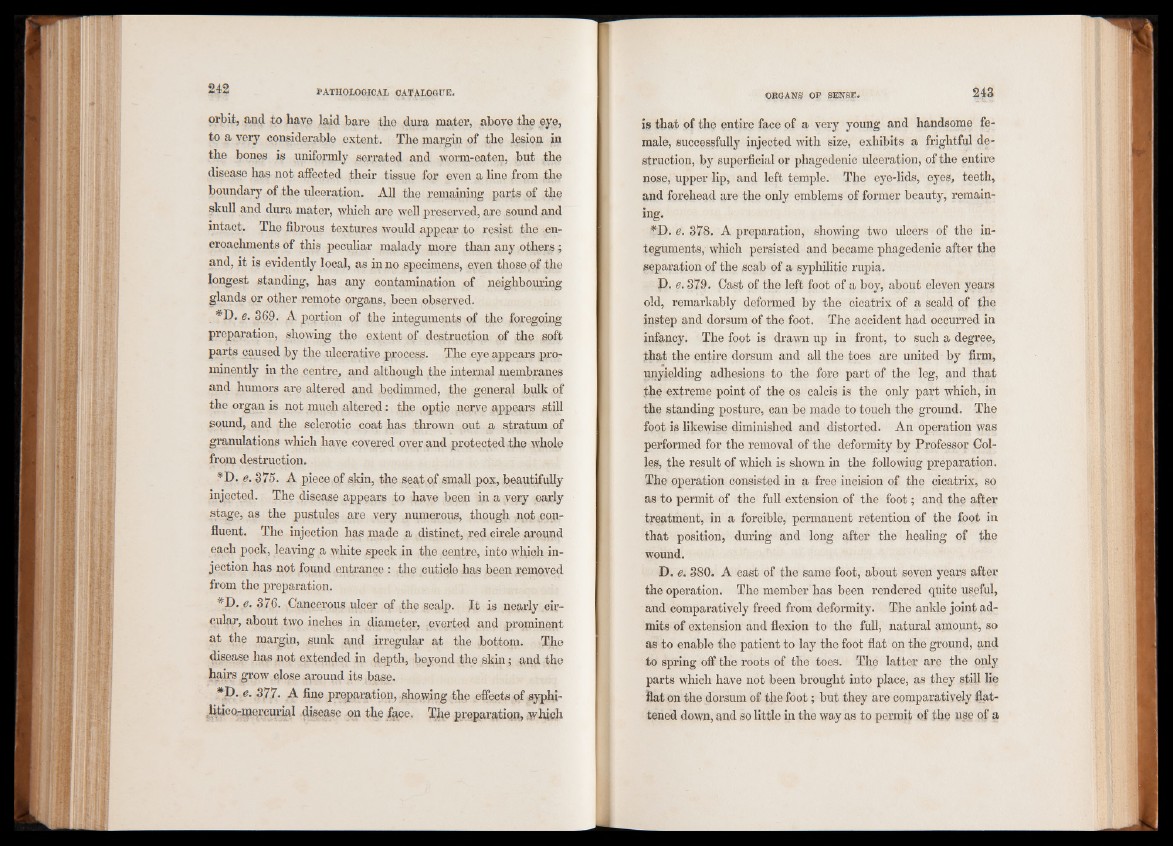
orbit, and to have laid bare the dura mater, above the eye,
to a very considerable extent. The margin of the lesion in
the bones is uniformly serrated and worm-eaten, but the
disease has not affected their tissue for even a line from the
boundary of the ulceration. All the remaining parts of the
skull and dura mater, which are well preserved, are sound and
intact. The fibrous textures would appear to resist the encroachments
of this peculiar malady more than any others ;
and, it is evidently local, as in no specimens, eyen those of the
longest standing, has any contamination of neighbouring
glands or other remote organs, been observed.
#D. e. 369. A portion of the integuments of the foregoing
preparation, showing the extent of destruction of the soft
parts caused by the ulcerative process. The eye appears prominently
in the centre, and although the internal membranes
and humors are altered and bedimmed, the general bulk of
the organ is not much altered: the optic nerve appears still
sound, and the sclerotic coat has thrown out a stratum of
granulations which have covered over and protected the whole
from destruction.
*D. e, 375. A piece of skin, the seat of small pox, beautifully
injected. The disease appears to have been in a very early
stage, as the pustules are very numerous, though not confluent.
The injection has made a distinct, red circle around
each pock, leaving a white speck in the centre, into which injection
has not found entrance : the cuticle has been removed
from the preparation.
3 76. Cancerous ulcer of the scalp. It is nearly circular,
about two inches in diameter, everted and prominent
at the margin, sunk and irregular at the bottom. The
disease has not extended in depth, beyond the skin; and the
hairs grow close around its base.
*D. c. 377. A fine preparation, showing the effects of syphi-
hticQ-mercurial disease on the face. The preparation, which
is that of the entire face of a very young and handsome female,
successfully injected with size, exhibits a frightful destruction,
by superficial or phagedenic ulceration, of the entire
nose, upper lip, and left temple. The eye-lids, eyes, teeth,
and forehead are the only emblems of former beauty, remaining.
*D. e. 378. A preparation, showing two ulcers of the integuments,
which persisted and became phagedenic after the
separation of the scab of a syphilitic rupia.
D, e. 379. Cast of the left foot of a boy, about eleven years
old, remarkably deformed by the cicatrix of a scald of the
instep and dorsum of the foot. The accident had occurred in
infancy. The foot is drawn up in front, to such a degree,
that the entire dorsum and all the toes are united by firm,
unyielding adhesions to the fore part of the leg, and that
the extreme point of the os calcis is the only part which, in
the standing posture, can be made to touch the ground. The
foot is likewise diminished and distorted. An operation was
performed for the removal of the deformity by Professor Col-
les, the result of which is shown in the foliowiug preparation.
The operation consisted in a free incision of the cicatrix, so
as to permit of the full extension of the foot; and the after
treatment, in a forcible, permanent retention of the foot in
that position, during and long after the healing of the
wound.
D. e. 380. A cast of the same foot, about seven years after
the operation. The member has been rendered quite useful,
and comparatively freed from deformity. The ankle joint admits
of extension and flexion to the full, natural amount, so
as to enable the patient to lay the foot flat on the ground, and
to spring off the roots of the toes. The latter are the only
parts which have not been brought into place, as they still lie
flat on the dorsum of the foot; but they are comparatively flattened
down, and so little in the way as to permit of the u,s.e of a